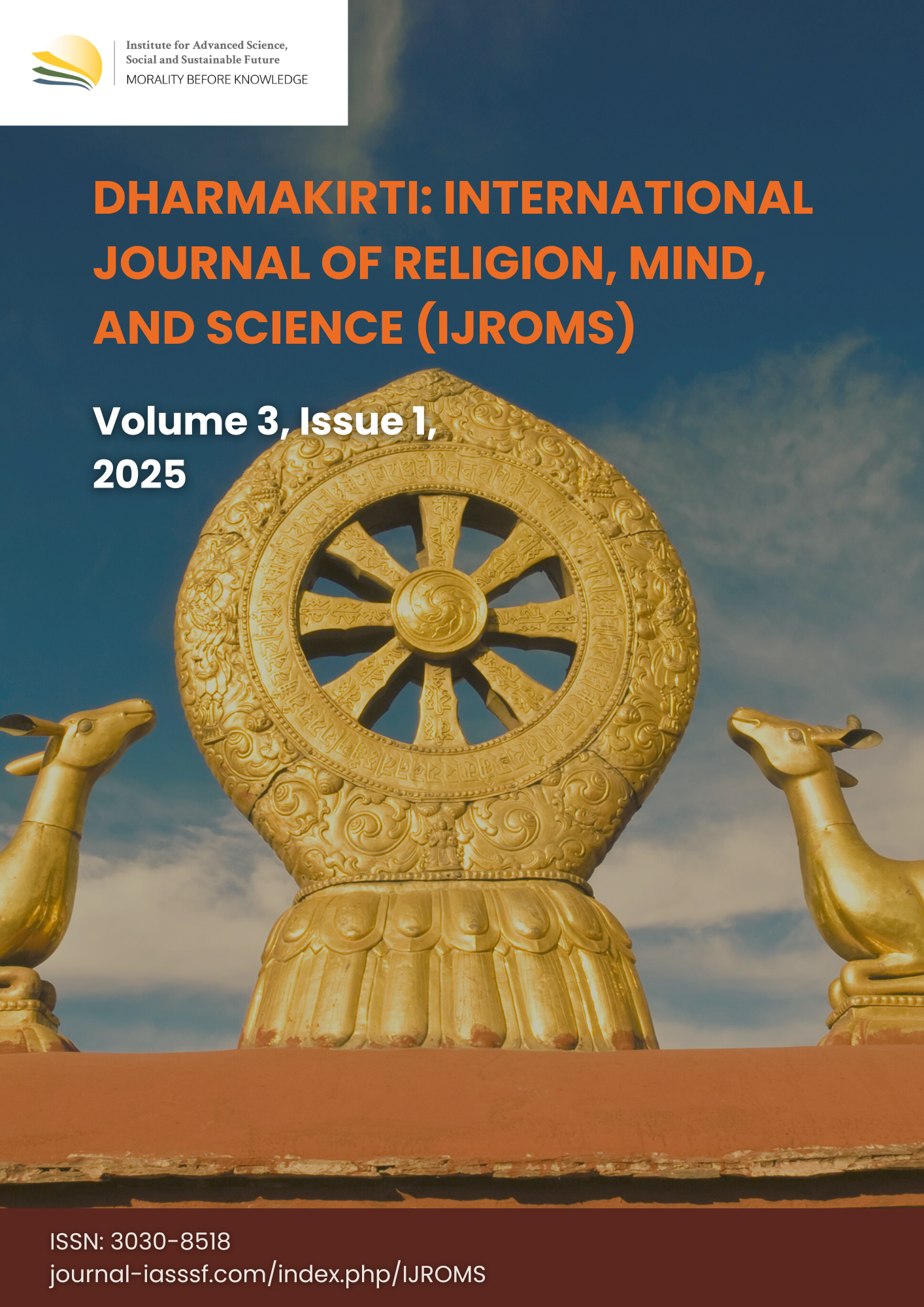Art, inscriptions, and sacred space: A survey of Śaiva traditions in Southeast Asia
DOI:
https://doi.org/10.61511/ijroms.v3i1.2025.2028Keywords:
Śaiva dharma, Southeast Asia, Śaiva traditionsAbstract
Background: The spread of Śaiva dharma in Southeast Asia is a vital chapter in the history of cross-cultural religious and political exchange between India and the wider region. This article traces the transmission of Śaiva ideas, rituals, and temple culture to the regions such as present-day Cambodia, Indonesia, Vietnam, and also includes examples from Laos, focusing on archaeological, inscriptional, and iconographic evidence. It investigates the royal patronage of Śaiva dharma, the regional adaptations of Indian forms, and the development of indigenous expressions of Śaiva worship. Methods: This paper is based on textual analysis, visual study of temple architecture, and secondary sources. Finding: The findings show that Śaiva practices were not simply imported from India but gradually integrated into local contexts through dynamic processes of reinterpretation, royal sponsorship, and ritual localisation. The study undertakes a regional survey of the spread and localisation of Śaiva dharma across Southeast Asia, drawing on epigraphic, architectural, and textual evidence. Conclusion: This study concludes that the spread of Śaiva dharma in Southeast Asia was not a one-way transmission from India, but a process of selective adoption, creative adaptation, and localisation. By examining evidence from Cambodia, Indonesia, Vietnam, and Laos, the research highlights how Śaiva traditions became deeply intertwined with local political authority, artistic production, and ritual life, producing uniquely regional forms of Śaiva practice that endured for centuries. Novelty/Originality of this article: The originality of this article lies in its comparative regional approach, which integrates epigraphic, iconographic, and architectural evidence to show how Śaiva dharma was reinterpreted within diverse Southeast Asian cultural settings.
References
Acri, A. (2006). The Sanskrit–Old Javanese Tutur literature from Bali: The textual basis of Śaivism in ancient Indonesia. Rivista di Studi Sudasiatici.
Acri, A. (2020). Yoga and meditation traditions in insular Southeast Asia. In G. Feuerstein, H. Singleton, & A. T. Jacobsen (Eds.), Routledge Handbook of Yoga and Meditation Studies (Chapter 23). Routledge. https://doi.org/10.4324/9781351050753-23
Acri, A., & Sharrock, P. (2022). The Creative South: Buddhist and Hindu art in mediaeval maritime Asia (Vol. 1: Intra Asian transfers and Mainland Southeast Asia). ISEAS–Yusof Ishak Institute. https://doi.org/10.1355/9789814951494-001
Ali, D. (2011). Courtly culture and political life in early medieval India. Cambridge University Press.
Bakker, H. (2019). Holy ground: Where art and text meet. Brill. https://doi.org/10.1163/9789004412071
Baptiste, P. (2014). Early Cham art: Indigenous styles and regional connections. In Lost Kingdoms: Hindu-Buddhist Sculpture of Early Southeast Asia (pp. 69–73).
Bhargava, P. (2012). Prambanan: A group of Hindu temples in Central Java. In Proceedings of the Indian History Congress (pp. 1440–1441). Indian History Congress.
Chemburkar, S., & Kapoor, S. (2018). Pāśupata sect in ancient Cambodia and Champa. In Vibrancy in Stone: Masterpieces of the Đà Nẵng Museum of Cham Sculpture (p. 48). River Books.
Coe, M. D. (2021). Angkor and the Khmer civilization (Rev. ed.). Thames & Hudson.
Coe, M. D. (2021). The Khmer Empire. In P. Fibiger Bang, C. A. Bayly, & W. Scheidel (Eds.), The Oxford world history of empire (Vol. 1, pp. 347–366). Oxford University Press. https://doi.org/10.1093/oso/9780197532768.003.0015
Cœdès, G. (1937). Inscriptions du Cambodge (Vol. V).
Coedès, G. (1968). The Indianized states of Southeast Asia (W. F. Vella, Trans.). University of Hawaii Press.
Coedès, G. (1975). The Indianized States of Southeast Asia (S. B. Cowing, Trans.). University of Hawaii Press.
Dumarçay, J. (1991). The temples of Java. Oxford University Press.
Goodall, D., Hatley, S., Isaacson, H., & Raman, S. (Eds.). (2020). Śaivism and the Tantric Traditions: Essays in Honour of Alexis G.J.S. Sanderson (Gonda Indological Studies, Vol. 22). Brill. https://doi.org/10.1163/9789004432802
Griffiths, A. (2012). Inscriptions of Campā: Linyi and the sixth century. Bulletin de l'École française d'Extrême-Orient, 99, 35–76. https://doi.org/10.3406/befeo.2012.6145
Griffiths, A. (2021). The Sanskrit inscription of Śaṅkara and its interpretation in the national history of Indonesia. Bijdragen tot de Taal-, Land- en Volkenkunde/Journal of the Humanities and Social Sciences of Southeast Asia, 177(4), 431–460. https://doi.org/10.1163/22134379-BJA10014
Guy, J. (2009). Artistic exchange, regional dialogue and the Cham territories. In A. Hardy, M. Cucarzi, & P. Zolese (Eds.), Champa and the Archaeology of Mỹ Sơn (Vietnam) (pp. 127–154). NUS Press.
Guy, J. (2014). Lost kingdoms: Hindu-Buddhist sculpture of early Southeast Asia, 5th to 8th century. Metropolitan Museum of Art.
Hall, K. R. (2011). A history of early Southeast Asia: Maritime trade and societal development, 100–1500. Rowman & Littlefield Publishers.
Heinzelmann, M., Hendrickson, M., & Evans, D. (2019). The social production of space and the fall of the Angkorian Empire. Antiquity, 93(370), 1036–1050. https://doi.org/10.15184/aqy.2019.95
Honig, E. (2020). Cambodia: From Khmer empire to modern times. University of Washington Press.
Honig, J. A. S. (2020). Revisiting the political process model: The case of the Khmer Rouge and the Cambodian Civil War. Journal of International Politics, 2(1), 34–52. https://doi.org/10.22259/2642-8245.0201003
Jákl, J. (2020). Writing for Eternity: A Survey of Epigraphy in Southeast Asia. Bijdragen tot de Taal-, Land- en Volkenkunde, 176(4), 591–620. https://doi.org/10.1163/22134379-17604008
Jash, P. (1977). Influence of Saivism in the Southeast Asian countries. In Proceedings of the Indian History Congress, 38, 620–631. https://www.jstor.org/stable/i40173308
Jash, P. (1977). Śaivism in Ancient Cambodia. Sanskrit Pustak Bhandar.
Kulke, H. (1978). The Devaraja cult. In H. Kulke (Ed.), The cult of the god king in South-East Asia (pp. 1–13). Monsoon.
Lavy, P. A. (2003). As in heaven, so on earth: The politics of Viṣṇu, Śiva and Harihara images in pre-Angkorian Khmer civilisation. Journal of Southeast Asian Studies, 34(1), 21–39. https://doi.org/10.1017/S002246340300002X
Mabbett, I. W. (1977). The ‘Indianization’ of Southeast Asia: Reflections on the historical sources. Journal of Southeast Asian Studies, 8(2), 143–161. https://doi.org/10.1017/S0022463400014839
Majumdar, R. C. (1927). Champa: History and culture of an Indian colonial kingdom in the Far East (2nd ed.). Gian Publishing House.
Majumdar, R. C. (1927). Champa: History and culture of an Indian colonial kingdom in the Far East (2nd to 16th century A.D.). The Punjab Sanskrit Book Depot.
Majumdar, R. C. (1986). Suvarnadvipa: Ancient Indian colonies in the Far East. Gian Publishing House.
Michael, V. (1998). Society, economics and politics in pre-Angkor Cambodia: The 7th–8th centuries. Centre for East Asian Cultural Studies.
Moens, J. L. (1986). Tantrayana in Java and Bali. (Reprint).
Perret, D. (Ed.). (2018). Writing for eternity: A survey of epigraphy in Southeast Asia (Études thématiques 30). École française d’Extrême Orient.
Phương, T. K. (2009). The architecture of the temple-towers of ancient Champa (Central Vietnam). In A. Hardy, M. Cucarzi, & P. Zolese (Eds.), Champa and the Archaeology of Mỹ Sơn (Vietnam) (pp. 155–186). NUS Press.
Pollock, S. (2006). The language of the gods in the world of men: Sanskrit, culture, and power in premodern India. University of California Press.
Rajarajan, R., & Palanikumar, S. (2023). Khmer art samplings: Ideological influence of Indian knowledge through Hindu divinities. International Journal of Research - Granthaalayah, 11(1), 20–28. https://doi.org/10.29121/granthaalayah.v11.i1.2023.4980
Regnier, R. (1966). Note sur l'évolution du chignon (jaṭā) dans la statuaire préangkorienne. Arts Asiatiques, 14, 17–40. https://www.persee.fr/doc/arasi_0004-3958_1966_num_14_1_956
Revire, N. (2022). The study of visual culture in South and Southeast Asian Buddhism. In Oxford Research Encyclopedia of Religion. Oxford University Press. https://doi.org/10.1093/acrefore/9780199340378.013.584
Sahai, S. (2016). Bhadreshvara: A forgotten form of Shiva in India and South-East Asia. B.R. Publishing Corporation.
Salomon, R., & Revire, N. (2023). A Unique Śaṅkhalipi (Shell script) Inscription from Si Thep, Thailand. Acta Orientalia Academiae Scientiarum Hungaricae, 76(3), 355–371. https://doi.org/10.1556/062.2023.00338
Sanderson, A. (2003). The Śaiva religion among the Khmers Part I. Bulletin de l'École française d'Extrême-Orient, 90, 349–462. https://doi.org/10.3406/befeo.2003.3641
Savitri, M., Acri, A., & Noerwidi, S. (2024). The Śaiva deities of the directions in the light of two recently discovered consecration deposits (peripih) from Central Java. Acta Orientalia Academiae Scientiarum Hungaricae, 77(1). https://doi.org/10.1556/062.2024.00444
Smith, M. (1999). The Indian roots of Cambodian kingship. In D. Gellner (Ed.), Hinduism in public and private: Reform, Hindutva, gender, and sampraday (pp. 39–61). Oxford University Press.
Suamba, I. B. P. (2007). Siwa Buddha di Indonesia: Ajaran dan Perkembangannya. Widya Dharma.
Sugriwa, I. G. B. (2003). Śiva-Buddha, Bhinneka Tunggal Ika. In I. Agastia (Ed.), Siwa-Buddha Puja di Indonesia (pp. 37). Denpasar: Yayasan Dharma Sastra.
Thel, S. (2022). State formation and hydraulic management in the Khmer Empire: New insights from remote sensing and historical sources. Journal of Southeast Asian Archaeology, 42(2), 211–234.
Venkatesan, A. (2019). Looking the other way: Inscriptions, murals, and signs in South Indian temples. South Asian Studies, 35(2), 173–188. https://doi.org/10.1080/02666030.2019.1667641
Vickery, M. (1998). Society, economics and politics in pre-Angkor Cambodia: The 7th–8th centuries. Centre for East Asian Cultural Studies.
Widnya, I. K. (2005). The Evolution of Shiva-Buddha in Indonesia. University of Delhi.
Widnya, I. K. (2008). The Worship of Shiva-Buddha in the Balinese Hindu Community. Journal of Religious Culture, 107, 1–12.
Wolters, O. W. (1999). History, culture, and region in Southeast Asian perspectives. Cornell University Southeast Asia Program.
Zakharov, A. O. (2010). A note on the date of the Vo-canh stele. Southeast Asian Review, 35, 17–21.
Zakharov, A. O. (2019, December). [Review of the book Writing for Eternity: A Survey of Epigraphy in Southeast Asia, edited by D. Perret]. Journal of the Malaysian Branch of the Royal Asiatic Society, 92(2), 142–149. https://doi.org/10.1163/22134379-17604008
Zoetmulder, P. J. (1968). Kalangwan: A Survey of Old Javanese Literature. Martinus Nijhoff.
Downloads
Published
How to Cite
Issue
Section
Citation Check
License
Copyright (c) 2025 Arhana Lochan

This work is licensed under a Creative Commons Attribution 4.0 International License.















